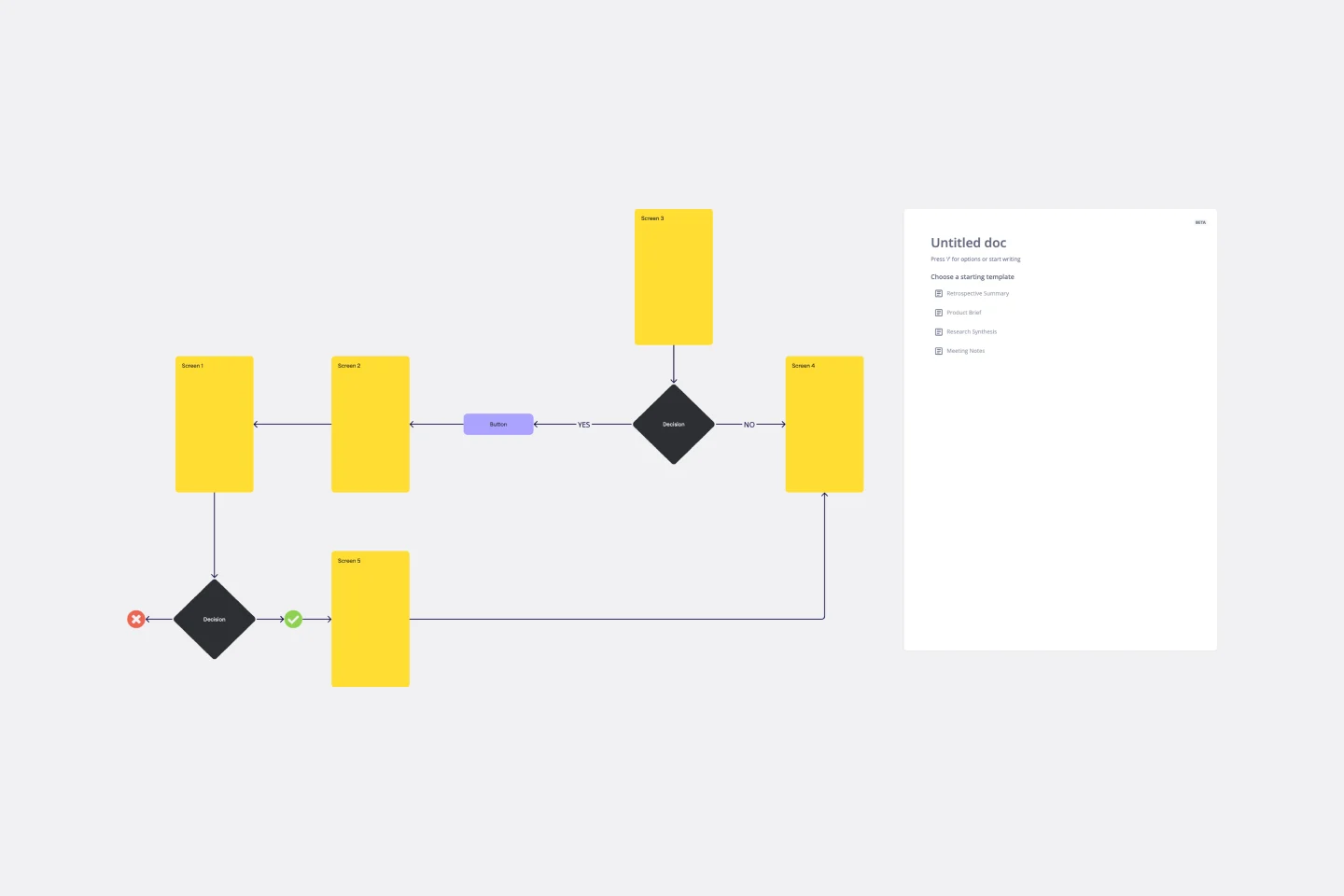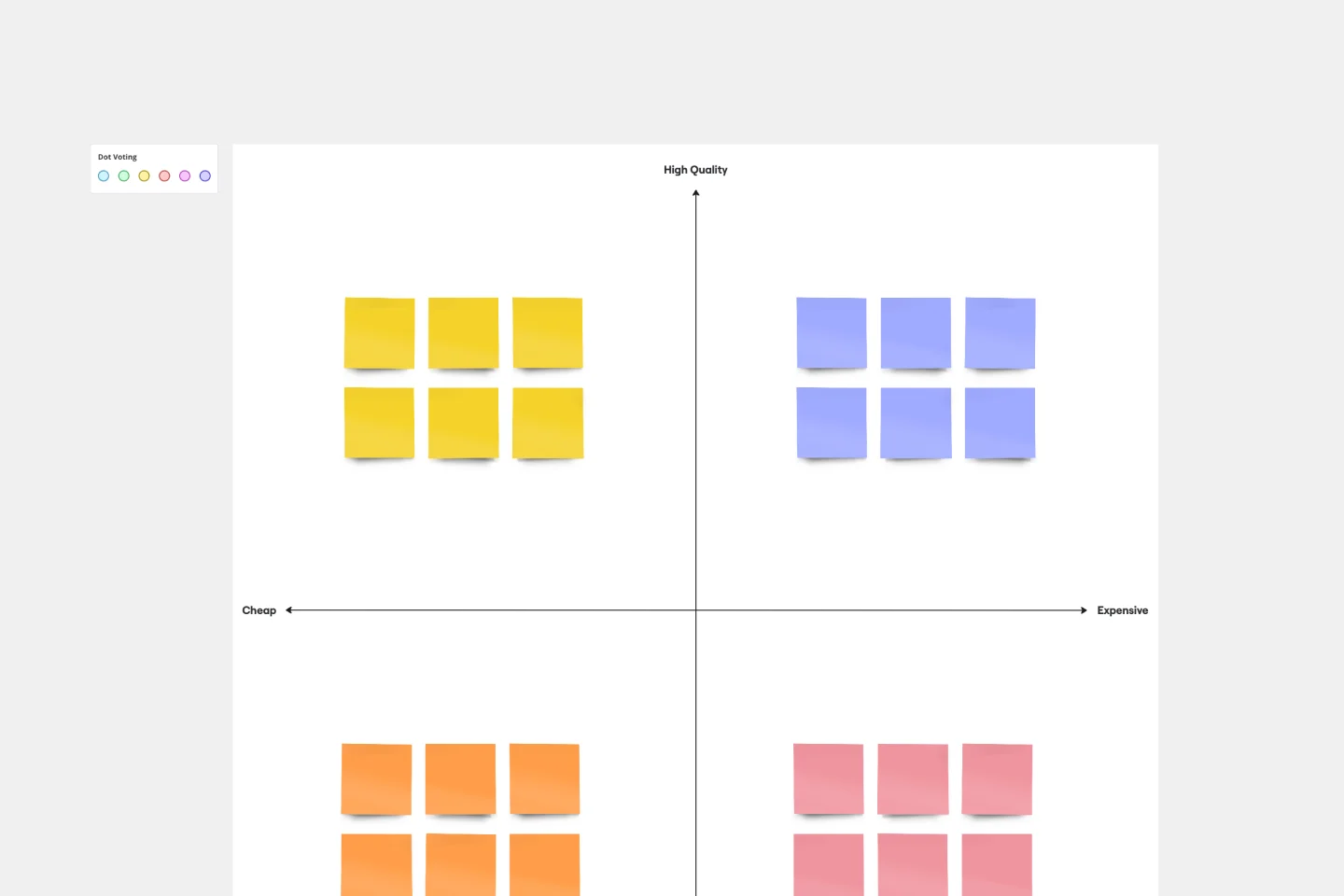About the HEART Framework template
The HEART framework is a UX framework developed by Google. It turns the often-fuzzy idea of user experience into a set of measurable, actionable metrics, helping your product win new users and keep current active users loyal.
What is the HEART framework?
User experience teams often find it challenging to develop useful metrics for success. It’s an even greater challenge for teams at large companies. You can measure user experience at a small scale through user research, surveys, and focus groups. But as your company grows, your customer base gets too large for these methods to always be reasonable.
Google developed the HEART framework to tackle the problem of quantifying user experience. The HEART framework is a set of user-centered metrics you can use to measure user experience at any scale — then draw on those metrics repeatedly throughout the product development lifecycle.
What does HEART stand for?
HEART stands for Happiness, Engagement, Adoption, Retention, and Task Success.
Happiness is a subjective measure of attitude or satisfaction. It’s often quantified through user surveys and bolstered via case studies.
Engagement measures how much the user interacts willingly with a product. Depending on the product, it can be measured by your number of active users in a day, week, or month or your net promoter score (NPS).
Adoption is the rate of new users gained in each time period, usually monthly.
Retention measures how long each customer remains an active user before dropping off. Churn, the other side of the coin, measures how many active users go inactive each month.
Task Success is either the average time it takes a user to complete a task in your product or the percentage of tasks users successfully complete.
What are goals, signals, and metrics in HEART?
Goals, signals, and metrics are the core of the HEART process. All five areas of the HEART acronym must be connected to a goal, at least one signal, and at least one metric.
A goal is a statement of what you’d like your product to achieve in that area of HEART. It’s important for goals to be general, not defined by existing metrics. Some examples:
Happiness goal: “We want logging into our product to feel relaxing and supportive.”
Engagement goal: “We want users engaging with our app every day.”
Adoption goal: “We want our user base to grow continuously.”
Retention goal: “We want as little churn as possible.”
Task Success goal: “We want to minimize abandoned tasks across all user segments.”
Next, come up with one or more signals for each goal. Signals are signs you can look for to show you whether you’re on track to achieve your goal. Examples might be:
Happiness signals: Positive feedback from with real users, recommendations, few complaints.
Engagement signals: Large amount of user-generated content, users spending more time in the app, users logging in multiple times per day.
Adoption signals: More downloads, new features adopted quickly, paid features generating more revenue.
Retention signals: More subscription renewals, fewer users going inactive.
Task Success signals: Few abandoned tasks, few complaints about time-to-completion.
Finally, decide on metrics you can use to objectively measure each signal. For example:
Happiness metrics: Number of five-star reviews, NPS.
Engagement metrics: Daily/weekly/monthly active users.
Adoption metrics: New users per day/week/month, revenue from paid users.
Retention metrics: Retention rate, churn rate.
Task Success signals: Tasks completed per user, average completion time.
The HEART framework is not prescriptive. You’re free to come up with whatever goals, signals, and metrics make the most sense for your business and product.
How do you create a HEART model?
Start by selecting the HEART framework template. Then follow these steps:
Decide on your scope. Are you evaluating your whole product, certain features, or just one feature?
Get familiar with the template. The five areas are listed at the top of the table. Goals, signals, and metrics run down the left-hand side.
Fill out goals for each column. Brainstorm or with your team to settle on five goals.
Fill out signals. Signals can be either positive (something you want to see) or negative (something you’re on the right track if you don’t see).
Fill out metrics. Pick metrics you can use to quantify each signal.
Alternately, you might choose to come up with goals, signals, and metrics for each column before moving on to the next one. Either approach works!
Once finished, you can share your framework with your team or anyone else who would benefit from seeing the information by sending them the board link.
When should you use the HEART model?
The HEART model is generally used to measure larger scale projects, but it works for any size project or team. Use it whenever you want to ensure you’re making your customers happy and providing them with real value.
HEART Framework Template FAQs
What are UX frameworks?
A UX framework is a set of assumptions and steps a team can use to build a user experience. UX frameworks such as HEART also monitor and refine user reactions to a product once it’s already out in the world.
What is a KPI in UX design?
A KPI, or key performance indicator, is a measurable variable a UX team can use to determine how their user interface is performing with customers. In the HEART framework, it’s called a metric. Examples include monthly active users and time to complete tasks.
What is UX tracking?
UX tracking is the act of using tools to follow how users interact with your product. It encompasses a wide range of technology, including website analytics, click-tracking, and A/B testing apps.
How do you use the HEART framework?
The easiest way is to use this free template. Alternatively, create a table and label one axis with Happiness, Engagement, Adoption, Retention, and Task Success. Label the other axis with Goals, Signals, and Metrics. Then, work with your UX team to fill in each cell.

Miro
Your virtual workspace for innovation
Miro is an innovation workspace designed for teams of every size, everywhere, to dream, design, and build the future together. Our mission? To empower these teams to create the next big thing, powered by AI at every step of the way. Over 90 million users around the world rely on Miro to untangle complex ideas, put customer needs first, and deliver products and services faster. All supported by best-in-class security, compliance, and scalability.
Categories
Similar templates
User Flow Template

User Flow Template
User flows are diagrams that help UX and product teams map out the logical path a user should take when interacting with a system. As a visual tool, the user flow shows the relationship between a website or app’s functionality, potential actions a user could take, and the outcome of what the user decides to do. User flows help you understand what a user does to finish a task or complete a goal through your product or experience.
Perceptual Map Template

Perceptual Map Template
To shape your messaging, tailor your marketing, improve your product, and build your brand, you have to know your customers’ perceptions — what they think of you and your competitors. You can gain those insights by exploring a perceptual map. This simple, powerful tool creates a visual representation of how customers rank your price, performance, safety, and reliability. Put this template to work and you’ll be able to size up your competition, see gaps in the market, and understand changes in customer behavior and purchasing decisions.
Buyer Persona Template

Buyer Persona Template
You have an ideal customer: The group (or few groups) of people who will buy and love your product or service. But to reach that ideal customer, your entire team or company has to align on who that is. Buyer personas give you a simple but creative way to get that done. These semi-fictional representations of your current and potential customers can help you shape your product offering, weed out the “bad apples,” and tailor your marketing strategies for serious success.
Product / Market Fit Canvas Template

Product / Market Fit Canvas Template
The product/market fit canvas template is used to help product teams meet customer and market needs with their product design. This template looks at a product in two dimensions: first, how the product fits user needs, and second, how the fully designed product fits within the market landscape. This combined metric understands a product holistically from the way customers use and desire a product, to the market demand. By comparing customer and product qualities side by side, users should better understand their product space and key metrics.
User Flow Template

User Flow Template
User flows are diagrams that help UX and product teams map out the logical path a user should take when interacting with a system. As a visual tool, the user flow shows the relationship between a website or app’s functionality, potential actions a user could take, and the outcome of what the user decides to do. User flows help you understand what a user does to finish a task or complete a goal through your product or experience.
Perceptual Map Template

Perceptual Map Template
To shape your messaging, tailor your marketing, improve your product, and build your brand, you have to know your customers’ perceptions — what they think of you and your competitors. You can gain those insights by exploring a perceptual map. This simple, powerful tool creates a visual representation of how customers rank your price, performance, safety, and reliability. Put this template to work and you’ll be able to size up your competition, see gaps in the market, and understand changes in customer behavior and purchasing decisions.
Buyer Persona Template

Buyer Persona Template
You have an ideal customer: The group (or few groups) of people who will buy and love your product or service. But to reach that ideal customer, your entire team or company has to align on who that is. Buyer personas give you a simple but creative way to get that done. These semi-fictional representations of your current and potential customers can help you shape your product offering, weed out the “bad apples,” and tailor your marketing strategies for serious success.
Product / Market Fit Canvas Template

Product / Market Fit Canvas Template
The product/market fit canvas template is used to help product teams meet customer and market needs with their product design. This template looks at a product in two dimensions: first, how the product fits user needs, and second, how the fully designed product fits within the market landscape. This combined metric understands a product holistically from the way customers use and desire a product, to the market demand. By comparing customer and product qualities side by side, users should better understand their product space and key metrics.